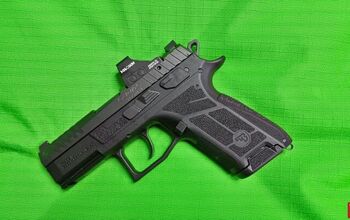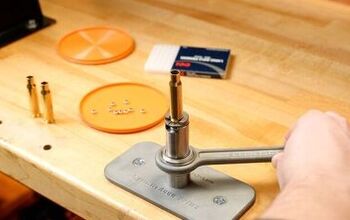TFB Review: Smith & Wesson M&P 2.0 Compact Optics Ready Pistol

Each year we are gifted with further advancements in firearms technology. Sometimes these come in the way of improved materials and construction, and sometimes they come by mating two existing technologies together to create something new. While red dot optics on pistols isn’t exactly a new concept, a concealed carry weapon with a compact red dot optic has only more recently come to the fore of concealed carry methods. With the growing popularity of carrying optics, Smith & Wesson has updated its popular 2.0 series Compact pistols to the Compact Optics Ready pistol.
Smith & Wesson sent me out a copy of their newly released M&P9 2.0 Compact Optics ready handgun for review and for someone who almost strictly uses red dot optics on pistols for competition use, this was a bit of an adjustment for me.
TFB Review: Smith & Wesson M&P 2.0 Compact Optics Ready Pistol
Before now, if you wanted to have a mini red dot sight on your handgun, you had to either order a custom slide or send out your slide to have it cut for the specific optic you wanted to mount on it. Smith & Wesson has eliminated the need for these kinds of services by offering the slide ready to go from the factory to accept several types of mini red dot optics.
The new M&P Compact Optics Ready pistol mates its 4-inch barrel with a standard magazine capacity of 15+1 from the factory putting it in Glock 19 territory in terms of size and capacity. Normally when you’re dealing with a red-dot equipped pistol, you’re usually sacrificing your sights either due to the optic being dovetail mounted or because your factory sights are too short to be of any use while the red-dot is equipped.
Red Dot COmpatibility/Installation
Smith & Wesson have had the foresight to actually include suppressor height 3-dot sights from the factory making this an even more attractive option for those looking to carry with a red dot optic. The pistol that I was sent included 7 different mounting plates for use with optics like the Leupold Delta Point Pro, C-MORE STS, and the Trijicon RMR and SRO. I chose to go with my Trijicon SRO for this particular review.
The mounting process is very straightforward, simply remove the included cover plate and save it for if you ever feel the urge to completely remove the red dot from your pistol. Each of the 7 mounting plates is lined up with a specific type(s) of red dot optics. Each of the plastic mounting plate adapters is stamped with a bold “TYPE” followed by its number. With the manufacturing processes available to us today, I would have much preferred the type of red dot optic the plate is compatible with be printed on there instead of having to consult the manual to find each specific paring. While this is a minor complaint, I feel it’s one that could help eliminate a lot of confusion for those new to red dot optics on pistols.
One other minor complaint is that the mounting plates are made from plastic instead of some type of metal. While the ones I used worked just fine, my personal preference has always leaned towards the more durable materials. I’m not exactly sure how much (if any) stress the mounting plate goes under during the firing of the pistol but having that bit of extra strength definitely wouldn’t have been a negative thing in my book – even for a few extra dollars.
Learning Curve
I have been very resistant when it comes to mounting red dots on pistols for any type of use. It took me a solid 3 years of Steel Challenge Competitions in the production class for me to finally bite the bullet and upgrade to a pistol with an optic on it. Carrying one as part of my every day carry setup is an entirely different leap of faith that has taken some getting used to.
On my initial range trip with the handgun, I wanted to get some baseline metrics for my personal performance as far as presenting the pistol. On average from the draw to the first shot I was getting about a 1.5 second time (only counting shots that made contact). To my surprise, when I switched over to the red dot optic I was finding that my times were significantly longer sometimes getting upwards of 3.5 seconds from draw to first on-target shot.
I think part of my hangup is from years of shooting with iron sights. Iron sights need to have equal light and equal height in order to be on target. For red dot optics, this is not the case. I constantly found myself attempting to “center” the dot inside the window of my Trijicon SRO and even though I compete with this particular optic using an MK IV 22LR pistol, I still found it to be difficult mostly because when I shoot with the MK IV I don’t have to draw from a holster.
Range Performance
I had to practice drawing and shooting with the red dot for a solid afternoon before I started getting closer to my baseline 1.5 second par time with the iron sights. Once I had gotten used to it, I found that all the benefits of having a red dot optic come naturally past getting that initial sight picture established.
In total, I probably used about 550 rounds of 150 grain Federal Syntch ammunition and when I went to take the optic off of the pistol, I found that it was still on as snugly as I had initially torqued it down. The pistol was not kept inside a case or holster during transport and was just tossed in my range bag and allowed to tumble about and even this did not dislodge or loosen the mounting of the optic to the handgun. All in all the mounting and performance of the M&P9 Compact Optics Ready pistol lived up to the legendary name that Smith & Wesson has built for themselves with the M&P series of pistols.
As a final note, I would highly recommend that you use full power factory ammunition or carry ammunition with the red dot mounted. With some lighter loadings, I found that the pistol tended to “short stroke” and empty casings would become caught between the optic and the barrel which would prevent the gun from cycling reliably. Always use appropriate ammunition for your particular applications!
Conclusion
Even though I found it a bit difficult getting used to the idea of a red dot on a carry piece, the M&P Compact Optics Ready pistol did its best to ease me into the idea. The pistol overall is a very soft shooting handgun with great out of the box features and a variety of mounting options for whatever red dot optic you plan on using.
I think if anything, the fact that Smith & Wesson is still coming out with adaptations of their popular designs just shows that they are willing to explore and adopt new ideas that come up within the firearms world. While I’m not quite ready to make the jump from iron sights to the red dot in my every day carry routine, the Smith & Wesson M&P 2.0 Compact Optics Ready pistol has given me more than enough reasons to start warming up to the idea.
Check Prices on S&W M&P 2.0 Compact Optics Ready Pistols
If you’d like to try out the Smith & Wesson M&P 2.0 Compact Optics Ready 9mm pistol yourself you can have one shipped to your FFL dealer for $616.00 MSRP.
We are committed to finding, researching, and recommending the best products. We earn commissions from purchases you make using the retail links in our product reviews. Learn more about how this works.

Reloader SCSA Competitor Certified Pilot Currently able to pass himself off as the second cousin twice removed of Joe Flanigan. Instagram: https://www.instagram.com/ballisticaviation/
More by Luke C.































Comments
Join the conversation
is there a benefit for the optic hood to be not flush with the top of the slide? the weird undercut looks like a snag point
So this is the M&P CORE but with a 4in barrel instead of 4.25?
Is the grip shorter? I can't recall if my CORE was 17 or 15 rounds...